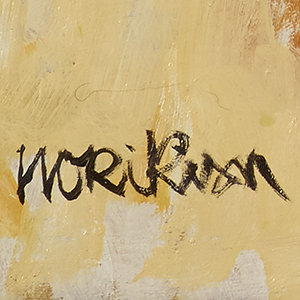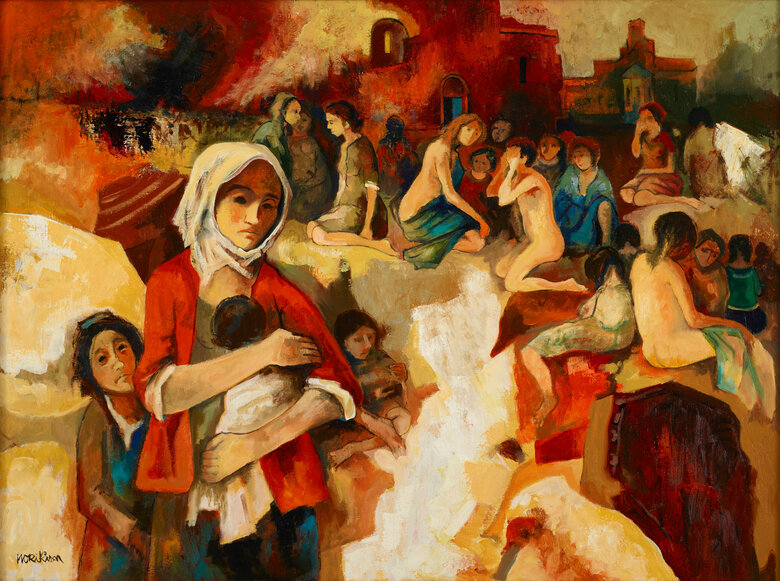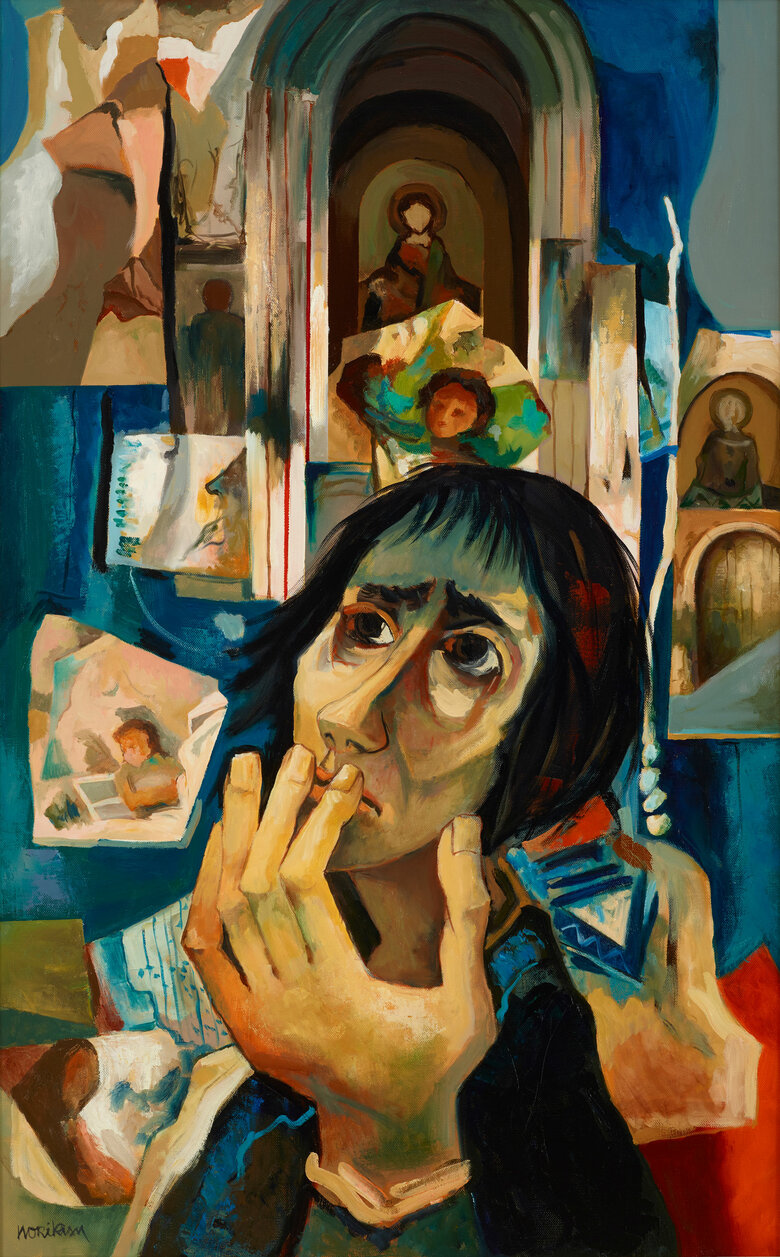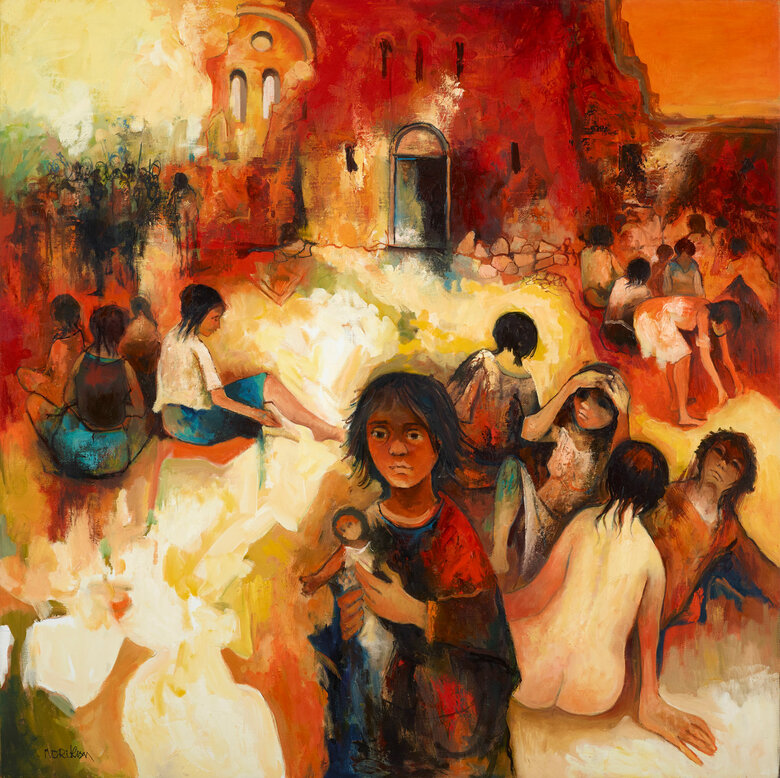Written by Liam Sibai Krikor Norikian, a Lebanese artist of Armenian descent, was born in Bourj Hammoud, Beirut, in 1941. He left school at the age of fifteen, after finishing his...


KRIKOR NORIKIAN, Lebanon (1941)
Bio
Written by Liam Sibai
Krikor Norikian, a Lebanese artist of Armenian descent, was born in Bourj Hammoud, Beirut, in 1941. He left school at the age of fifteen, after finishing his primary education at Saint Georgiore School of the Jesuit fathers, and in order to support himself and his family, began working as a typesetter at his uncle’s printing press[1]. An avid illustrator, Norikian began attending classes at the Italian Institute of Fine Arts, Bab Idriss, in Beirut in 1959, mentored by Fernando Mannetti and Jean Khalifé. In 1963, Norikian studied drawing and painting at the Gudver Art School for three years and worked there as an assistant instructor. The artist then studied at the Pietro Vanucci Academy in Italy in 1965, where he completed his first engravings. The following year, he organized an exhibition of his engravings at the hall of L’Orient newspaper, upon his return to Beirut[2]. In 1968, Norikian enrolled at the Ecole Superieure des Beaux-Arts in Paris at the studio of Lucien Coutaud for etching, and that of Legreaux for painting.
Seeing as the artist was Interested in figuration and in printing, his eventual involvement in lithography seems rational. A colleague of the artist introduced him to a calligrapher who owned a lithograph that was sitting, collecting dust on a Bab Idriss rooftop. After some haggling, Norikian acquired the machine. He cleaned it, bought some lithographic stones, and produced many of the works that he would display between 1969 and 1970[3].
In 1971 Norikyan won the first prize at the AGBU-sponsored Armenian Painters of the Middle East. By 1976 his stay in Paris had been reinforced and prolonged as the Lebanese civil war reached new intensity. By 1976, the exodus that had already occupied his work at that point, had properly doubled down on itself within the artist; Norikian became an immigrant twice.
Earlier in his career, the artist produced a lot of engravings and lithographs. The engravings were mostly colorless. In The Walk (1968) we see a group of women looking in different directions in what seems to be a vacant space. However, any strictness in the nature of this space is challenged by a strange horizon of sorts that is articulated in flatness. Even so early on in Norikian’s artistic evolution, we see the artist terribly interested in space and perspective, as well as showing its fluid, even apriori nature. Norikian’s paintings are populous yet spacious and vacant, indicative of the presence of civilization yet explicitly outdoors and somehow naturalistic. His works took to the aforementioned portrayal of the mass evacuation of people. Norikian emphasized the presence of women and children and brought out whatever amount of vulnerability he could from their faces and thin bodies. Armenian Church (1981) is a vibrant lithograph that includes one of the earlier appearances of cathedrals in Norikian’s paintings, an inhabitant that would frequent his work.
In 1988, northern Armenia experienced a devastating earthquake that took over twenty-five thousand lives and left hundreds of thousands without shelter. Norikian’s subject matter, palette, and general tenor remained largely the same throughout his career but his work experienced a notable shift after this historic event .The work suddenly arrives at a different approach to composition. As critique Joseph Tarrab writes
breathing becomes jerky, stability gives way to convulsion, the earthly foundation disappears, handling tightens[4]
Heritage D'un Peuple (1990), part of the Dalloul Art Foundation’s collection, is an oil painting that encapsulates Norikian’s demeanor of defenselessness, his concern with evacuation, with architectural relics, and his disruptive understanding of space. In a logic close to that of Cezanne, in this work subjects do not inhabit a space, they exude it; they are spaces. We see a crowd of people emerging into the foreground from the upper left corner of the painting. As the group approaches the audience, the bodies seem to fall down, not as bodies in this represented setting, but in where they are positioned on the canvas, emphasizing the importance of flatness in navigating depth. Also in the foreground, to the left of this falling section of the crowd, a woman and her children. She seems to be on a platform that is simultaneously lower than, on equal footing with , and totally separate from that of the aforementioned group.
The artist tried his hand are portraits and still lifes as well. There is even some intersection between the more intense moments of suffering and the tamer, more conformingly painterly subject matter of his still lives and portraits. Norikian also produced a notable number of nudes, many of them in the manner of his visions of exodus. With a work like Bear Breasted Woman, 1992, vulnerability means something completely different. We see the woman reclining against what seems to be a surface, but that appears to the audience, due to their prolific angle as a stick or cane of sorts. The cane essentially divides the painting into two uneven sections. On the other side of the painting, is an individual that seems to inhabit the same space differently from the bare chested woman. This other person sits before a canvas. However, this canvas is on the woman’s side of the painting, behind and just above her shoulder. As if this canvas is on the elevated part of steep incline, although the presence of any such body that supports the canvas is not present.
No vitality was lost as the artist pushed 70. Also part of the Dalloul Art Foundation’s collection, L'Horreur, 2010, is another potent exploration of space. In the painting’s center an individual grazes their mouth and chin with their fingertips as if in reflection. This person is articulated with great sharpness relative to the rest of the painting. However, their hand seems about as big as their torso and head. Behind this figure, there are several little pockets of space, windows into rooms whose up-down and front-back orientations are distinct from each other.
[1] William Matar, “KRIKOR NORIKIAN,” One Fine Art, Lebanese, arab artist painters, sculptors, graphic, poets, calligrapher, art galleries, 0AD, https://www.onefineart.com/artists/painters/Krikor-Norikian.
[2] Cesar Nammour, Norikian (Beirut, Lebanon: Fine arts Publishing, 2007).
[3] Cesar Nammour, Norikian (Beirut, Lebanon: Fine arts Publishing, 2007).
[4] Joseph Tarrab, “KRIKOR NORIKIAN,” Krikor Norikian, 1994, http://www.roslin.com/artinfo/artframes/krikor_norikian.htm.
Sources
Matar, William. “KRIKOR NORIKIAN.” One Fine Art, Lebanese, arab artist painters, sculptors, graphic, poets, calligrapher, art galleries, 0AD. https://www.onefineart.com/artists/painters/Krikor-Norikian.
Nammour, Cesar. Norikian. Beirut, Lebanon: Fine arts Publishing, 2007.
Tarrab, Joseph. “KRIKOR NORIKIAN.” Krikor Norikian, 1994. http://www.roslin.com/artinfo/artframes/krikor_norikian.htm.
CV
Selected Solo Exhibitions
2010
Krikor Norikian, Hamazkayin Lucy Tutunjian Art Gallery, Beirut, Lebanon
2012
مع الوقت, Bank Byblos, Beirut, Lebanon
Selected Group Exhibitions
2015
ولادة أمة من جديد, Beirut Exhibition Center, Beirut, Lebanon
2012
Art from Lebanon - Modern and Contemporary artists: 1880 – 1975:, Beirut Exhibition Center, Beirut, Lebanon
2010
collective exhibition on Armenian Genocide victims, Hamazkayin Lucy Tutunjian Art Gallery, Beirut, Lebanon
Press
Krikor Norikian.pdf
El Shark Online.pdf
Press Release Norikian 191112 AR.pdf
- جريدة المستقبل.pdf
Arts et Culture.pdf
La Revue du Liban.pdf
Avec le temps _ une expo du peintre Krikor Norikian - iloubnan.info.pdf
Lebanon Files.pdf
News - Hamazkayin Lucy Tutunjian Art Gallery.pdf
Laure Ghorayeb.pdf
Tchilingirian_Hratch_Witness_of_His_Time_AIM_March_2000.pdf
KRIKOR NORIKIAN Artwork
Become a Member
Join us in our endless discovery of modern and contemporary Arab art
Become a Member
Get updates from DAF
Follow Artists
Save your favourite Artworks
Share your perspectives on Artworks
Be part of our community
It's Free!
We value your privacy
TermsCookiesPrivacy Policies
Become a Member
Get updates from DAF
Follow Artists
Save your favourite Artworks
Share your perspectives on Artworks
Be part of our community
It's Free!
We value your privacy
TermsCookiesPrivacy Policies
Become a Member
Get updates from DAF
Follow Artists
Save your favourite Artworks
Share your perspectives on Artworks
Be part of our community
It's Free!
We value your privacy
TermsCookiesPrivacy Policies
Welcome to the Dalloul Art Foundation
Thank you for joining our community
If you have entered your email to become a member of the Dalloul Art Foundation, please click the button below to confirm your email and agree to our Terms, Cookie & Privacy policies.
We value your privacy, see how
Become a Member
Get updates from DAF
Follow Artists
Save your favourite Artworks
Share your perspectives on Artworks
Be part of our community
It's Free!
We value your privacy
TermsCookiesPrivacy Policies








